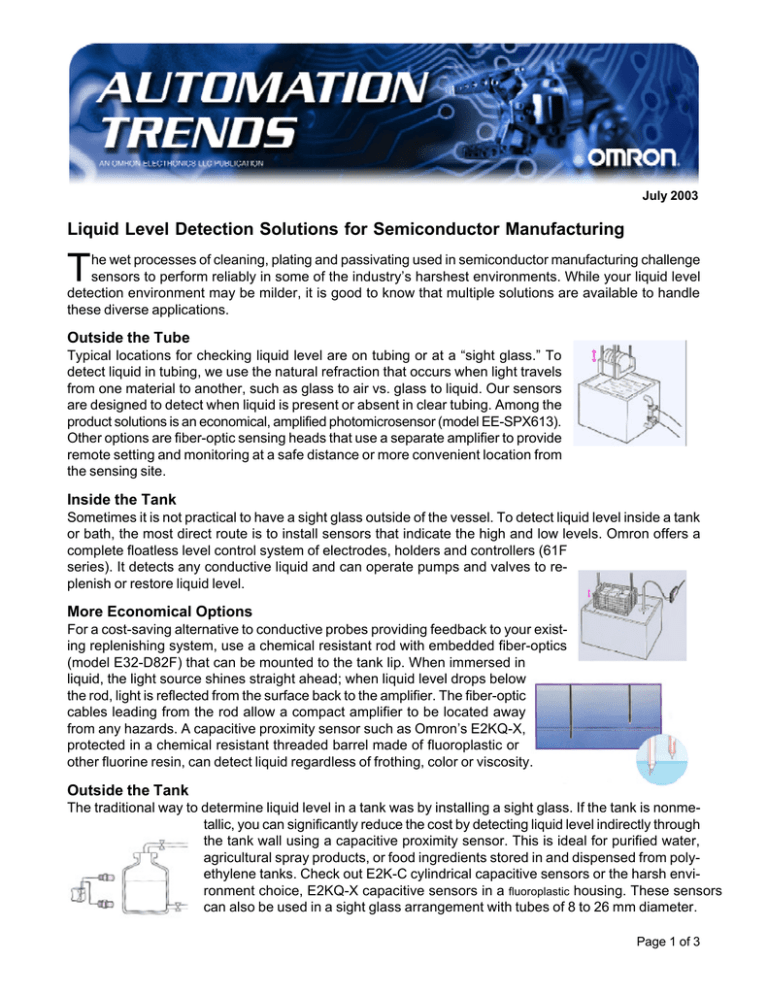
July 2003
Liquid Level Detection Solutions for Semiconductor Manufacturing
T
he wet processes of cleaning, plating and passivating used in semiconductor manufacturing challenge
sensors to perform reliably in some of the industry’s harshest environments. While your liquid level
detection environment may be milder, it is good to know that multiple solutions are available to handle
these diverse applications.
Outside the Tube
Typical locations for checking liquid level are on tubing or at a “sight glass.” To
detect liquid in tubing, we use the natural refraction that occurs when light travels
from one material to another, such as glass to air vs. glass to liquid. Our sensors
are designed to detect when liquid is present or absent in clear tubing. Among the
product solutions is an economical, amplified photomicrosensor (model EE-SPX613).
Other options are fiber-optic sensing heads that use a separate amplifier to provide
remote setting and monitoring at a safe distance or more convenient location from
the sensing site.
Inside the Tank
Sometimes it is not practical to have a sight glass outside of the vessel. To detect liquid level inside a tank
or bath, the most direct route is to install sensors that indicate the high and low levels. Omron offers a
complete floatless level control system of electrodes, holders and controllers (61F
series). It detects any conductive liquid and can operate pumps and valves to replenish or restore liquid level.
More Economical Options
For a cost-saving alternative to conductive probes providing feedback to your existing replenishing system, use a chemical resistant rod with embedded fiber-optics
(model E32-D82F) that can be mounted to the tank lip. When immersed in
liquid, the light source shines straight ahead; when liquid level drops below
the rod, light is reflected from the surface back to the amplifier. The fiber-optic
cables leading from the rod allow a compact amplifier to be located away
from any hazards. A capacitive proximity sensor such as Omron’s E2KQ-X,
protected in a chemical resistant threaded barrel made of fluoroplastic or
other fluorine resin, can detect liquid regardless of frothing, color or viscosity.
Outside the Tank
The traditional way to determine liquid level in a tank was by installing a sight glass. If the tank is nonmetallic, you can significantly reduce the cost by detecting liquid level indirectly through
the tank wall using a capacitive proximity sensor. This is ideal for purified water,
agricultural spray products, or food ingredients stored in and dispensed from polyethylene tanks. Check out E2K-C cylindrical capacitive sensors or the harsh environment choice, E2KQ-X capacitive sensors in a fluoroplastic housing. These sensors
can also be used in a sight glass arrangement with tubes of 8 to 26 mm diameter.
Page 1 of 3
Spill Detection, Just in Case
One of the risks involved with stored liquids is undetected spillage. That can create hazards for personnel
in the form of slippery spots on the factory floor or, worse, an inhalation or contact risk due to toxicity. A
low-cost solution, Omron’s model K7L-AT50D, helps you stay ahead of hazardous spills. The sensor
detects leakage by monitoring the resistance from a conductive sensing band. Place the band on the floor
near the chemical tank or process container. If a leak occurs, the K7L will provide a signal.
Learn More Here
The following tables provides some additional information about products described in this article.
Outside the Tube
Features
Light-ON/
Dark-ON
operation;
NPN output;
compensation
for old/stained
tubing
Light-ON
when fluid is
present;
minimal
influence from
bubbles and
water drops
Appearance
Applicable
Amplifier
Unit
Built-in
E3X-DA-S
or
E3X-MDA
Thin profile
type for dense
mounting
applications;
detect level
differences of
4 mm
E3X-DA-S
or
E3X-MDA
Fits all size
tubing;
minimal
influence from
bubbles and
water drops
E3X-DA-S
or
E3X-MDA
Sensing distance
Standard
object
Model
Applicable tube:
Transparent tube (FEP or
comparable transparency)
Tube diameter:
6 to 13 mm, with 1 mm walls
Pure
water at
25°C
EE-SPX613
Permissible
bending
radius
--
Applicable tube:
Transparent tube (FEP or
comparable transparency)
Tube diameter:
3.2, 6.4 or 9.5 mm
Applicable tube:
Transparent tube (FEP or
comparable transparency)
Tube diameter:
6 to 13 mm
Applicable tube:
Transparent tube (FEP or
comparable transparency)
Tube diameter:
8 to 10 mm
E32-A01
4 mm
E32-L25T
10 mm
Applicable tube:
Transparent tube (FEP or
comparable transparency)
Unlimited tube diameter
E32-D36F
4 mm
E32-A02
Page 2 of 3
Outside the Tank
Features
Appearance
Capacitive
proximity
sensor,
threaded
cylindrical
chemicalresistant
Applicable
Amplifier
Unit
Built-in,
NPN-NO
Sensing distance
Standard
object
Model
6 to 10 mm
Detects metallic and nonmetallic objects
50 x 50 x
1 mm
mild steel
E2KQ-X10ME
Permissible
bending
radius
--
Built-in,
SCR-NO
3 to 25 mm
Detects metallic and nonmetallic objects, including
materials inside nonmetallic containers
50 x 650
x 1 mm
mild steel
E2K-C25__1
--
fluoroplastic resin
housing
Adjustable,
distance
capacitive
proximity
sensor
Spill Detection
Features
Applications
Monitor the resistance
between sensing bands for
leaks of water, alcohol or
liquids with impedance up
to 50 MΩ.
Standard
object
Any
conductive
liquid
Model
K7L-AT50D
Amplifier
F03-16PE Sensing band
(add length to model
number)
Copyright 2002 by Omron Electronics LLC All Rights Reserved
Page 3 of 3




